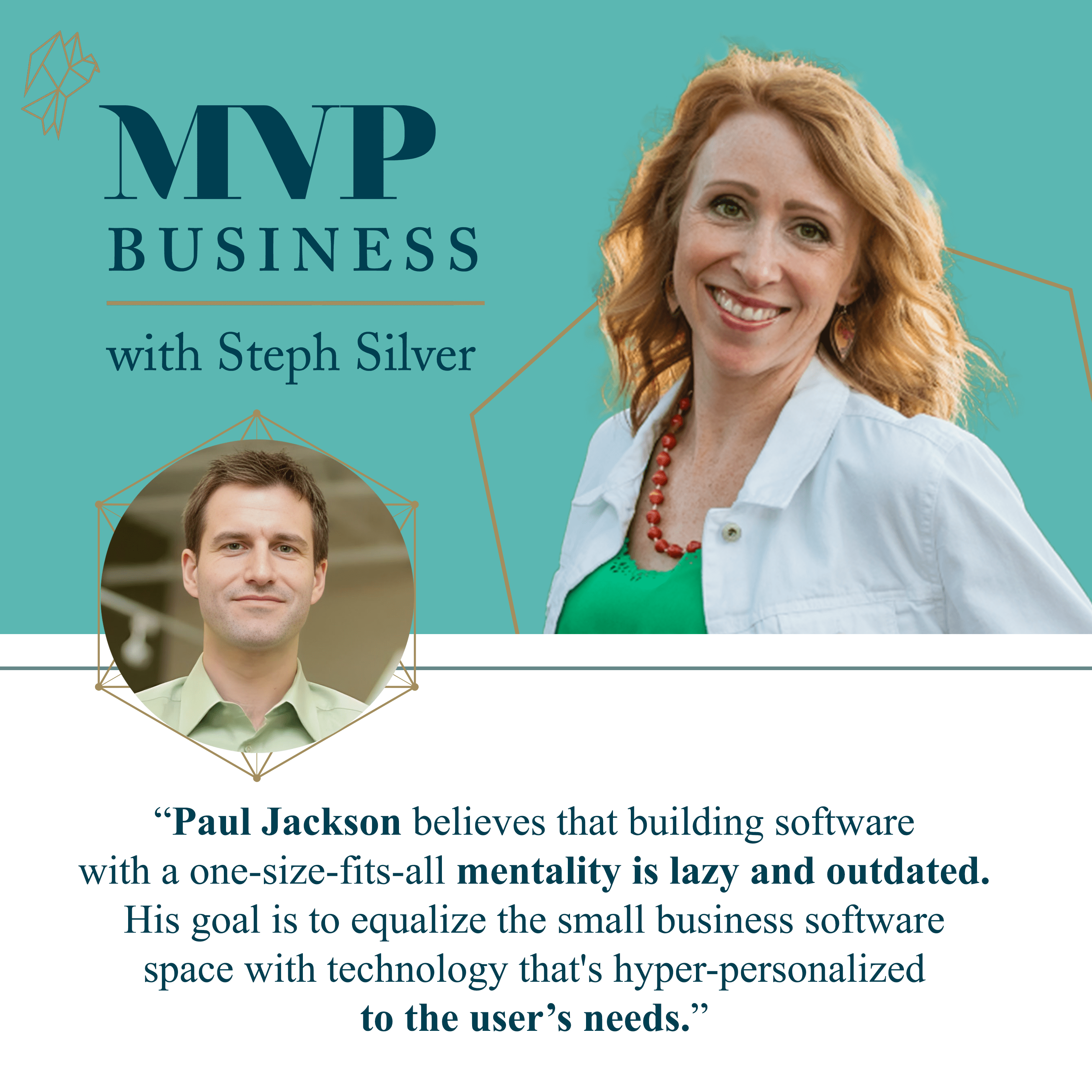Posted on December 18, 2023
It doesn’t matter if you are a small business; you can still compete in your industry. Method provides a better way to run your business that pen, paper, and sticky notes can’t. Today, Paul Jackson, the Founder and CEO of Method, brings us the value of process automation. He takes us into his transition to Method and how he runs it. He also talks about how he manages himself as he grows his business. Mark then touches on how Method helps other businesses grow by automating your processes. Be an MVP in your business, and tune in to this episode with Paul Jackson today.
—
Listen to the podcast here
Process Automation: How Method Can Grow Your Business With Paul Jackson
Our guest is Paul Jackson. Paul is the Founder and CEO of Method, a process automation tool for growing businesses on QuickBooks and Xero. A two-time founder, Paul believes that building software with a one-size-fits-all mentality is lazy and outdated. His goal is to equalize the small business software space with technology that’s hyper-personalized to the user’s needs. Thank you so much for joining us, Paul.
Thanks for having me. It’s a great intro.
Thank you so much. There’s something in your history that is super interesting to me. I want to dig in by asking you this question. You started your first business while living in a bike shed. How did that happen? How did that come about? Tell us a little story about what you were doing in that bike shed to begin with and how you came up with a business idea.
I was paying $200 a month to survive in Kingston, Ontario, Canada in a little bike shed off the kitchen of some people I knew. How do they get there? To rewind, I was always an entrepreneur, even as a kid. I would do odd jobs in the neighborhood. I would probably have 5 or 6 things going on at any one time. Even before I could have things in the neighborhood, I’d had things in my own household. I would go around and collect shoes and try and sell them back to my family members. That didn’t go very well.
I was either stealing the donuts that were put out in the kitchen or trying to open a bakery. That didn’t work very well either. My parents must have thought it was humorous. My first business was doing landscaping. That was my summer job. I’m not the only person who has that as their summer, but I’m pretty wild on it. It was a pretty big operation for a little 13 to 14-year-old. I had 130 lawns that I would maintain and hired a bunch of my fellow classmates. That was what I did all the way through high school.

That is definitely more of an operation than most kid’s lawn mower.
It was an operation. Billing was a pain in the butt. Early on, I realized a whole automation of billing would be a great thing for people like me. I ended up going to a university called Queens, which is a well-known university up here. There’s a commerce program that has marketing, finance, accounting, and all that. People from that program tend to go to work for Goldman Sachs, McKinsey, and all these great places and they wear suits. I realized, by the time I had my fourth year of university, that it wasn’t me. I wasn’t going to wear a suit. I realized I needed to start my own business right out of school. It was always the long-term plan to start my own business, but I knew that I’d be miserable wearing a tie. I made a decision in my fourth year to start up a software company.
I learned how to code a little bit when I was small. My grandfather had put together computers and taught me how to code when I was four years old. They hadn’t done much with it, and then I realized I needed to start my own company. I was like, “I’ll do a software company. Maybe I’ll solve the problem that I had when I was running my landscaping business in high school and start there.” I took a few courses that fourth year, but I put things off a little bit and slowed down the academics. I didn’t take enough courses to graduate so I stuck there in Kingston. I then made my first sale.
One little company out of Miami had bought my software on eBay and I was like, “Clearly, there’s a market for this.” There’s one company out of Miami that wants my software and has made it to solve my own problems. The next sale didn’t come and so money ran out and I ended up doing the cheapest possible thing, which was living in a bike shed for a while. That lasted until I finally graduated a year later in this little tiny place called Kingston, Ontario. From there, a real big business began. I had lots of customers, by the way, in Texas.
You skipped over a big chapter and then a whole other big successful business happened. The end.
I’d go deeper. Should I start there?
What was the transition between that business that didn’t do well to starting your next venture?
That business eventually did do well. That business was acquired by a private equity company out in New Jersey. We had grown to 25 people and sold it. That was in 2010. It starts off horribly. It was a tough few years road. I eat baked beans for morning, lunch, and dinner but never gave up. I think it’s probably an entrepreneur’s story. It doesn’t work right away until you figure it out.
Some people give up. Some people start over. Some people keep eating the baked beans for way too long. Tell me a little bit more about why you held on to that. Did you start your other company simultaneously?
That company started from the bike shed and became a company that maybe some realtors known as QXpress, which is a field service scheduling software that now operates under the WorkWave brand. It took quite a while to gain traction. It wasn’t until I had a group of great customers that decided to be basically my forum of testers. They helped me iterate fast when I was in year three, but I knew they were onto something. Neither I kept going. I would solve a lot of those problems. That company did grow and we had quite a lot of revenue. As I said, I have 25 staff who built it.
What kept you going in those first three years when you weren’t quite catching it or getting the revenue? You knew it was going to work. You had an idea.
As you said, some people continue to eat the baked beans forever. Some people figure it out and some give up. I know most will figure it out. I know I’m never going to give up. Eventually, I figured it out. QXpress was a success. I had a group of early users who helped me and also there’s the epiphany that we had. Way back, it was just me, which was all small businesses were field service. Some people go out and do work on properties and get invoices made and then paid. They all use QuickBooks. If you are a rep field software, what they’re already using is QuickBooks. There’s a market, and that is what kicked things off for me. This was way back. We’re talking about early 2000s now, so I’m dating myself. Those were many years ago.
Was it even QuickBooks then?
Yes, it was QuickBooks.
You sold that company. What was the transition to Method?
At that time, I was fully bootstrapped, which meant that I had no external funding and the acquirers were in the US and Wall Township, New Jersey. We offered our staff to go there if we wanted to move there. We didn’t have any takers so we decided to transition the business to the new owners. A few of us sat around thinking, “That was great. We had a great run. We solved a whole bunch of problems for a bunch of customers. What do we do next?” We thought, “What’s the biggest problem for the small business customers we have now? What do they face?” We found that no two businesses were the same even if they were in the same industry or in different locations. I got Texas lawn care companies from a New York one.
A plumber from Florida is different from a plumber from Chicago. Even if their location is the same or their business is the same, they are different. As they grew, they outgrow us, and that was always hard. We thought, “What if we allow our customers to make their own features? What if our software product was a product that allowed self-development? What would that be?” It was a geeky day. We sat there in the boardrooms, brainstorming away. We noticed a couple of things that supported our brainstorm. One was we had this form designer in our product which allowed tradespeople who are not programmers to make their own invoices, reports, and work order templates. They would spend all this time making these amazing creations but dragging, dropping, and configuring.
We knew they didn’t mind spending time building things because they’re entrepreneurs. They build things for a living. The other thing we recognized was we had been efficiency geeks and we had grown without funding. We had grown with efficiency because we had this guy Pete on staff. Pete was the guy who was hired to do our mobile app development. He was always pulled off mobile app development into our internal systems. The classic one is our sales team would say, “If I call my customers and it’s raining in the area, they always pick up because they can’t go out and do work in the field. They’re in the office so they should pick up the phone.” It’d be so cool to see our customer list. There’s an icon of a cloud or rain if it is raining and a sun if it is sunny.
That would help me call the right people at the right times. Pete would go and code it, put it into our internal systems, and then we close a lot more sales calls. We had so many little Peteisms. The idea was if everyone had their own Pete, all these small businesses would compete against the largest companies. If they had their own Pete, they could compete against large companies much better. Wouldn’t it be cool to do that? Wouldn’t it be cool to give power to the small businesses that are currently stuck with being in a one-size-fits-all software product? That was Method and that was a couple of years ago.

Process Automation: Give power to the small businesses who are currently stuck with just being in a one-size-fits-all software product.
That’s so brilliant to think about. What’s the most efficient and effective thing in our company? It’s Pete. How do we duplicate Pete for everyone?
Everyone should have a Pete.
It’s absolutely true. I think about that from a branding standpoint. I’m able to go into my website and make little changes but so many different companies can’t. It’s like, “I realize that this particular word is causing a problem. We need to have another button or whatever it is.” It’s the same thing in software and tools. If you can change a little bit, it’s going to be so much more effective or if you’re particular customer base is going to pay their invoice 10% quicker if it says something different or the dollar amount isn’t presented in a different way. You mentioned in there that you were bootstrapped with the first company. Is Method also bootstrapped?
No, because we had that success of selling the first company. We had funding initially. The funding was the Bank of Paul. I bankrolled the company for the first few years until we had traction and then I did something that I thought I would never do. They reached out to venture capital. I think the reason why I did that is because when I did sell the first company, I myself became an investor. I invest in quite a few local startups. I saw that there isn’t an evil side to VC and there isn’t an evil side to investing but there’s also a helpful side.
I figured that if I found the right partner, I would accelerate the growth of my company versus doing it alone. Now we are venture funded. We still maintain control of the company internally, which keeps us on our product vision. We always make sure we don’t deviate from our product and what we’re trying to do for our customers. We do have external funding which helps us grow faster.

Process Automation: Make sure we don’t deviate from our product, and we’re trying to do it for our customers, but we do have external funding, which helps us grow faster.
I would love for you to talk about that a little bit more because it’s become much more ingrained in tech culture to ask for and get venture funding or to find Angel investors and accelerate growth. We’ve seen throughout the last couple of years the benefits and detriments of that. As you said, there are evils and angels that come along. There are a lot of small business startups or whatever it is that are afraid of debt in general.
They’re afraid of investments or taking on that next level of investments and investors. They’re afraid of taking on that next level but that’s the thing that might get them to that next stage of their business. Since you have seen it from multiple different angles from being the bootstrap, investing in your own, getting an investor, and then also investing in other companies, talk to us about how it changes the dynamic maybe what you looked for in in a partner. What it has enabled you to do or what you’ve seen when you are an investor in other businesses?
I’ll start off by saying that I don’t think taking investments is for everyone. You first have to look at what your goals are. If it’s about building a business and selling it for as much money as possible, I would say that investment might be the thing for you because it’s a math question. Do you want a smaller piece of a bigger pie? Is that piece worth more than a big piece of a smaller pie? If the math pays off, do the math and take the investment. I don’t think a lot of us do all this for money. We entrepreneurs are wired to build something and the money is just a measurement. I would say if your plan is to have a lifestyle business where you’re going to build something and retire from it years from now, you probably shouldn’t take those investors.
Look at your goals. If it's just about building a business and selling it for as much money as possible, then that investment might be the thing for you because it's a math question. Click To TweetYou should take venture investors. A venture investor needs to get out in ten years so don’t take venture. Take that or take someone who shares your values. Also, it depends on your industry. The service business plan doesn’t need some investment that a software company. We call SaaS, Software as a Service. SaaS pretty much needs to take venture and that’s partly because that’s the way the math works. You put a whole bunch of R&D and sales cost to acquire customer but they pay you back every month for 4 or 5 years. How do you buy your next customer if you’re waiting for the first customer to pay you back? Venture and big investments handle that cashflow problem.
If you do decide that investment is for you, whether it’s math or to fulfill your vision in the timeline that’s reasonable to you, you should expect to change a dynamic a little bit. You are definitely more accountable to someone else in you before. I remember that first feeling when I had my first board meeting. For the first time, I was always accountable to my team and now I was accountable to someone else. It’s almost like I had a boss. It’s weird because I never had a boss before and I had to answer to the board. Whether you have a board or some investors, you still have to answer to them. It will change your dynamic a little bit. It’ll make you accountable. That’s okay for most people because it’s forcing function to reflect, whether it’s once a quarter or once every six months.
You’re going to reflect on how you did, and whether you are on track with the goals that you promised. That’s healthy to do. If you don’t want to take investors and you still want that same accountability, maybe have your own for yourself into the same thing if you can. You asked how I looked for an investor. I felt we didn’t need much capital because we already had traction. I wanted a smaller boutique Series A investor. We talked to a number of them here in Toronto. In Series A, you want to go local. The reason why is they help out with recruitment is because they’re connected. If your Series A is local, I looked local. I found a company called Klass Capital. They had a small fund at $25 million fund. We hit it off.
They had the same passion for what we were doing. I explained what we did to one of the partners. He said, “I get it. It’s like NetSuite for QuickBooks. This is perfect.” He understood instantly. I’m like, “That’s what we do. We are like an ERP but for small businesses who don’t know what an ERP is. That’s right.” We hit it off right away and it’s been great for me since because their experience teaches me things I don’t know about yet. That’s fine. I don’t know everything but they either know or they can put me in touch with people who are about to go to the next level that I’m going to next. You can get that in various ways. You can get them forum groups. You can get them from local YPO chapters but you also get them from good investors. Thanks for your 25 questions.
It’s close. Thank you for sharing that because that’s something that I’ve talked about before but you never know what stage of business someone is in. The next thing that I want to talk to you about is growth. You mentioned software and development. What you’re doing is the staff that is working with you. They’re not inexpensive easy-to-find folks. How do you find people that align with your passion, commitment, and vision?
It’s changed over the years. We’re 100 people now. About half of those are our technical folks like the developers, quality control, and product managers. The other half is service and marketing but they are all very skill-based. In the early days when we were Sub 20, we were always looking for other startup people who loved ambiguity, had full context but were in the same room, and did not create structure, just wanted to build things. If you hired one of those people now at a 100-person company, our placement, a lot of time, will love it. In reality, they wouldn’t be successful because you hired here now require structure at a 100-person company.
What I was always able to do in an interview process either directly by being in the interview or by teaching others how to explain what we do. It is to share the vision of what we’re trying to accomplish at Method. That is to empower small businesses to be super-efficient and compete against the big guys. Everyone knows someone who runs a small business whether it’s their family member or their friend’s parents or something like that. Everyone else has a soft spot for a small business owner who wants to succeed. When you explain how we’re trying to help them, they get excited. As long as we stick to our product vision and try to build to life, people stay.
People stay as long as we stick to our product vision and bring more trying to build life. Click To TweetIs there anything that you’ve done in your business in Method that is specifically geared toward culture other than hiring through vision? For some people, the culture comes organically and naturally and others put a lot of time and effort into building a thought-out culture.
Core values get a bad name sometimes. It sounds all corporatey and like an exercise. For us, it has been helpful. Twice over the years, we’ve run values exercises, but the second time we did it was the most successful. We looked at who people around the company admired the most. We surveyed. We asked them to list the qualities that they had that made them admire them. We aggregated all this data and summarized it, and things are being helpful. It came up being customer-centric. We had less of these values. Figuring out what makes us tick and who the best people are for us and then using that to hire, recognize, and review time to increase time has helped us have the right people on the bus and make them happy and get people who don’t show those values into a different role of different company.
You mentioned Pete earlier and it sounds like you’re good at recognizing the value in your team members. Is that something that comes naturally to you or is there someone on your staff that you’ve brought along with you over time that is good at that? Is that something that organically happened based on how things have run?
I wouldn’t say I’m super good at that. I don’t think I’m great at coaching. I’m not the best coach and I’m not necessarily the best at recognizing flags. I might have a blind spot in hiring. I do look for people who share my passion and who are amazing problem solvers. That’s what I’m looking for but I do have other people on my team who are good at this. I have my head of operations who picks up on all the little nuances that go right off of my head. I have my head of sales and service who’s like an octopus with how many times he can see at once and understand whether someone is a good fit for the rest of the team. I have to surround myself with people who have that because I don’t think I do it myself.

Process Automation: Surround yourself with people who have the eyes to see whether someone’s a good fit for the rest of the team.
That’s a good point. Obviously, we’re always still learning about ourselves. How long did it take you to see that you needed those types of people around you?
I don’t think it was a purposeful decision. It’s to the realization one day. You gravitate to things that you’re good at and that you enjoy doing. That leaves a gap because of the things that you don’t enjoy doing and things that you are neglecting. You have to fill it with someone else. It’s being filled by someone else who does have that passion and competency. One day, you look around and you’re like, “That’s getting done now. You’re pretty good at it. You’re better than me and I should recognize that.” For me, it’s more organic than purposeful in terms of filling those gaps. For the most part, I have a new executive starting in a chief of staff role, which is what I happened to have before.
It came with the recognition that I’m so stretched now as a leader of these 100 people that certain promises and commitments that I used to be able to make and execute, I can no longer do myself. Every entrepreneur can commiserate it with me and how that feels. You feel like you’re letting everybody down. I don’t want to be in that state anymore. I’ve hired someone who can execute on strategy that goes across the team. What happens now is that there’s a marketing product and sales initiative but that’s three liters. His job is to do it. He’s going to be busy. It’s my job, which as a CEO, I will ever going to do. That’s the chief of staff role that I’ve hired for. Sometimes, I do make purposeful hires based on deficiencies we have within our company. Other times, it’s more of someone else that fills the gap.
To me, it’s showing the skill in hiring that you have that people automatically fill those gaps because it takes a certain type of person and a certain type of culture for that to happen, especially now. I’ve been working since I was eight years old and have seen lots of different businesses from the inside out. It seems like now more than ever, people want to stay in their lane.
It’s like, “That’s not my role. That’s not what I was hired to do.” When I talk to or coach young people, I always say, “There’s nothing that is outside of your job description if you want to grow or if you want to lead. You can get taken advantage of if you do that too much but notice those gaps and filling them or saying, ‘I’ve been feeling this. I can’t keep doing it. Can we hire someone and be willing to bring it up?’” I wanted to say that if you have a comment, but I have another question.
This is quick. I may not have observed a shift in the market because the market may have shifted while we grew. I remember, in the earlier days when we were twenty people and on the other side of the boardroom table hiring, someone would ask, “Why do you want to work here?” This was mid-2015 or around there. They asked for almost always be from the right candidates anyway. I want to work somewhere where I can see how it all works and be involved in multiple things like in the kitchen making dinner. If people aren’t saying that anymore who are working for a twenty-person company, that’s a real shame if that’s the case.
There are still people saying that. It’s just a matter of listening for it in the interview process and saying that’s the one. Even if you don’t have 100% skills that we’re looking for, you’re willing to be in the kitchen and learn. That’s definitely a skill in and of itself or a trait that is amazing. The question that I have then is about your growth. Again, it’s an amazing personality trait of your own that you’ve grown from this easy-to-manage.
You can see everybody in one room concept of 20 people to 100 people where you may know everybody’s name but you may not know them well or they’re families. How do you deal with that personally as a leader knowing that you are going to continue to grow? How do you manage your own stress, fear levels, and all that comes with knowing that you have a big payroll to at least pay everyone?
I’m stoked about the last part of that. The beautiful thing about SaaS business is predictable because it’s the same revenue coming in every month. I don’t have to stress about finances to know what they’re going to be months out. I make sure we don’t spend more than we can afford. On the question on how do you handle the growth, it’s been hard. As someone who has grown from 0 to 100 and never work for a large company, I’ve had to learn all those levels myself on the job. There’s no way of doing that other than working for someone else or living it. The milestones would be at 10, 20, 40, and 80. Ten is when a small business owner has done the things that worked before that no longer work.
You’ve grown up, everything is in your head, you run a lot of the processes, you own a lot of things still, and you start finding yourself apologizing to your staff that you’re not getting back the money promise that you would or to your customers or to any stakeholder. It’s because you’re holding on to too much and that’s when you need to figure out how to automate some of the things you’re doing and delegate certain tasks. That’s the area where we at Method help small businesses. It is how to help them automate things that they should be holding on to anymore. Outside Method, growing here, twenty was when you have multiple managers. That’s when you are no longer as much an individual contributor but you’re a manager of managers.

Process Automation: Figure out how to automate some of the things you’re doing and how to delegate tasks.
That begins around there. At 40, that was the hardest for me because, at that point, you need real structure and process. That’s typically when you bring in some of the outside. That’s when it gets hard because you can bring people up and they’re set up to succeed. They were there when it was twelve. Going from 12 to 20 and making them a manager, they’re going to be okay as long as they have those management traits and they have a desire for it. They can be fine. Take them to 40 where they’re the managers of managers of managers, that’s a skillset that they have not developed yet so you’re looking from the outside. From the outside, they come in because they’ve only worked at 40-person companies.
That’s all they seem to remember and they’re like, “Why don’t you have this process? Why don’t you have this structure? I’m looking at the Mickey Mouse operation you are running here.” That’s the feeling you get and you get this little bit of Imposter syndrome where you’re like, “We didn’t need it.” In reality, you didn’t need it. That’s why you didn’t do it and that’s absolutely okay but it takes some growing up to do. One of the hardest phases is around 40. Getting the 80 is painful because then some of that scaffolding you put up around 40, you can peel it away because it’s bureaucracy.
You can get rid of it now because the engine is running by itself. As a leader, this is the hard one. If you’re at 80, you’re in meetings all damn day. You’re not doing any of the things you used to do. You’re the domain expert and the one making sure the ship is steering in the same direction, all the rowing the boat, and all are rowing in the same direction. That’s your job. 80 to 100 is the same thing. That’s where I am now. I am making sure that, being in the meeting, everyone is rowing the boat in the same direction.
How do you do that? How do you consistently ensure that your mission, vision, and passion are still rowing the boat and not in a constant hand-holding or marionetting?
There are frameworks that are quite simple to use that help with this. The one that we use is Traction EOS. They have a way of taking your company’s vision, making a 3-year plan or a 10-year plan, and sharing that with the team with planning with regular weekly and monthly check-ins. We follow EOS because it’s a well-documented framework that we don’t have to invent ourselves. It starts with the vision, building an annual plan, building a quarterly plan, and making sure everything ladders up. It allows you to communicate and communicate because you can never over-communicate the plan or the why. Everyone forgets the why until you keep reminding them. That’s what we do. We use EOS. It’s great.
Do you bring your financial team in on that and make sure they are aware of and aligned with the vision as well? Sometimes, in a lot of larger companies, they are left out of the vision and mission process
I mentioned, as an entrepreneur, you need to learn how to let go of things. I never let go of finance. I’m almost in the room. For me, I could do finances in my sleep. That’s a skill I have. I may have a lot of deficiencies but that’s one thing I can do easily. Finance is always included. If we did not include finance and strategic discussions, I can see exactly what you’re talking about, it would be friction. If the marketing team brings me, we call it CAC to ARR, which basically has more acquisition costs.
Entrepreneurs need to learn how to let go of things. Click To TweetThey’re recurring in revenue. It’s a very important stat. If they show a low number, that means that we’re doing well but leaving money on the table. It instantly says, “Spend more.” They know in the back of my head that there’s a financial model to support that so we can move much faster on things with me as the finance guy.
I love that you are strategic about finance and also understand the value of spending more to make more when it’s being done correctly. Being on the marketing and sales side of lots of different types of businesses, it seems to me that technology companies are some of the businesses that falter in understanding the concept and direct correlation of spending money to make money. They think that their product is so good that it’s going to sell itself. That’s a big challenge that I’ve seen but obviously, they had that.
That’s false that most goods are going to sell themselves. There’s something in SaaS called Product-Led Growth or PLG. It’s all about, “A product should support, sell, and market itself.” If you look at all the top PLG companies, they all have sales teams and support teams. It’s more of a guiding principle in reality. You absolutely do need to do both and no problems on itself. I thought you were going to go into how a software company doesn’t need to make a profit. That is a finance problem because that one might change now with the headwinds we’re seeing in the economy but there’s math that mostly supports the argument each way.
That’s interesting. I’ve always questioned that and do not understand how these tech companies can be around for decades and never make a profit. Explain it to us.
First of all, if they’re being a responsible business and they’re growing rapidly, say it did cost you $1,000 to a customer. Over their lifetime or over many months, they pay for $1,000. That first year, you might break even on that customer. In the second year, you’ll make a profit. If you’re going to wait until the second year to invest in getting another customer, you’re going to go slow to acquire two customers. Over the course of the year, you’ll probably show a loss because you’re not going to recoup all that. If you stop the marketing spend and wait for your customer’s monthly recurring revenue to catch up, you’d be profitable but then you wouldn’t be growing very fast. The idea is that you look at the customer’s value over their lifetime rather than on the one-year P&L.
You say, “They’re doing pretty well.” There’s another way of looking at it, which is a slightly more irresponsibly looking at it in software. That is it sometimes makes sense to acquire a customer that’s not going to be profitable because the venture capital is a private equity. The acquirers will pay a higher multiple of revenue, not of profit, than the customer’s even worth. They will spend irresponsibly because they know that they will get higher funding or a higher exit by growing rapidly. That to me is crazy and that should fade away into oblivion. We shouldn’t be talking about this years from now.
Both of those concepts make sense to me. How is it that there are companies that are well-known, have been in business for 2 or 3 decades, and they still have never shown a profit? What would make that happen? Why does that make sense in anybody’s mind? That doesn’t compute for me.
There’s a term called The Rule of 40. A healthy company is one that is doing 40. The 40 is you take your revenue growth and you minus your loss or you plus your profit. If you’re growing at 20% and you have a 20% profit line, you’re 40. You’re doing great. If you’re growing by 80 but you’re losing 40%, you’re still doing great. Maybe this company has been around for twenty years that you are talking about and loses money every year, they’re growing so rapidly that their rule of 40 is still very much positive. They’re in a land-grab scenario where it grabs all the land it can grab and then figures out how to make a profit out later because it’s very hard for someone else to grab that land once you’ve grabbed it. People smarter than me can probably explain that one.

Process Automation: The Rule of 40 says a healthy company is doing.
I understood it. My threshold for pain wouldn’t delegate me a leader in that business but it computes better than it did before so I appreciate you explaining that.
I told you I do finance.
We don’t have a lot of time left, but tell me how your business helps others. What’s the benefit of working with you and bringing on your company, Method, to make sure to help people grow, their businesses grow, and automate?
We haven’t spent much time talking about what Method even is right. Method, on the surface, is a CRM that works with people’s accounting software namely QuickBooks or Xero. The idea is that it sucks the entire customer list, invoices, and payments out of QuickBooks and puts them into their CRMs. Their sales reps have all the up-to-date information necessary to answer questions from customers and do all the basics here and things. What Method is more is a platform that allows people to build custom apps. We have all kinds of customers. We have 3,500 companies and 35 custom instances that do anything on the lead-to-cash workflow that automates your business better. For example, there’s this company that sells guitar picks and the CEO was still doing all the actual payments.
The Method is a platform that allows people to build custom apps. Click To TweetHe’s processing all the payments for the purchases of guitar picks. She asked us to make a button on the payment screen that would prevent her other staff members from receiving payments. That was for customization ask. We’re like, “You could do it yourself but we could do that for you. Before we customize it for you, can we ask why?” “If they’re above $1,000, I want them paying with ACH because I get a better rate than if they pay with a credit card. If they’re less than $1,000 then they can pay with a credit card.” “If you trust your employees to do that and not make a mistake, would you do it?” “Yes, but I can never trust them to do it.”
I go, “We make a button that makes that decision for you, press the button on the screen, and accept payments over $1,000 with ACH or less than $1,000 with a credit card?” “You could do that?” We changed her life. Three hours a day, she was processing payments as the CEO of a guitar pick company. It’s a pretty well-known brand by the way. That’s one example of one simple thing we do but there’s more there’s more complicated examples like this medical cabinet maker who was still making all their estimates themselves.
It’s so complicated to build a quote for medical cabinets because every medical cabinet is different. They’re doing all that in Excel because all these formulas would be in an Excel file. We replicated his entire process inside Excel and moved to Method where the actual estimation process of this was a bunch of click buttons that other people could do. We saved them hours a week doing that. It costs them $400 in customization. Anything along the process from making a quote, receiving a payment, making an invoice, or whatever it might be that requires automation to free up those entrepreneurs from all the chaos that they’re still holding on to, that’s what we do.
That’s fantastic. I can see the application of that across the board. What’s the best way to learn more? Do you do demos? Where should your potential customers find you?
If you go to Method.me/MVP, then we will have a link for them to go through. It’ll give them some more steps on how they could figure out which processes they should automate. They can also do a free trial on the website, Method.me. We definitely do demos. We do free customizations. We can put little buttons and figure out whether they charge ACH payments or the custom estimates. We have a team that can help automate their companies.
I can see how that changes a small business entirely. There are so many more questions that I could ask but we are at a time. I encourage everybody to check out that link, Method.me/MVP or go to Method.me and find the free trial and figure out what’s the best way to bring automation into your payment and estimation process. Are there any last words that you would like to share with us, Paul?
If you are one of those 0 to 10 owners who is starting to face the chaos, figure out soon what it is that you want to automate or what you want to delegate because it’s going to get worse if you don’t. The Method.me/MVP has an actual checklist to help you go through that.
If you are one of those 0 to 10 owners starting to face the chaos, figure out soon what you want to automate and delegate because it will get worse if you don't. Click To TweetThank you so much. Check out that checklist, guys. Thank you so much, Paul, for all of this information. It’s been valuable to me. I know that there are some definite nuggets in there for our customers, including that checklist. Thank you so much for joining us.
You’re very welcome. Thanks for having me.
I want to thank our show supporters Eminence M&A Solutions and Tower Commercial Real Estate. I want to thank you for reading. If you like it, tell your friends. Follow us on Instagram and LinkedIn. The mission of MVP business is to dig deep into the lives of true leaders so that others can follow knowing that the path isn’t always easy but the journey is worth it. Enjoy the day and live with passion.
Important Links
- Method
- Klass Capital
- Method.me/MVP
- Eminence M&A Solutions
- Tower Commercial Real Estate
- Instagram – Vine Collective
- LinkedIn – Vine Collective


